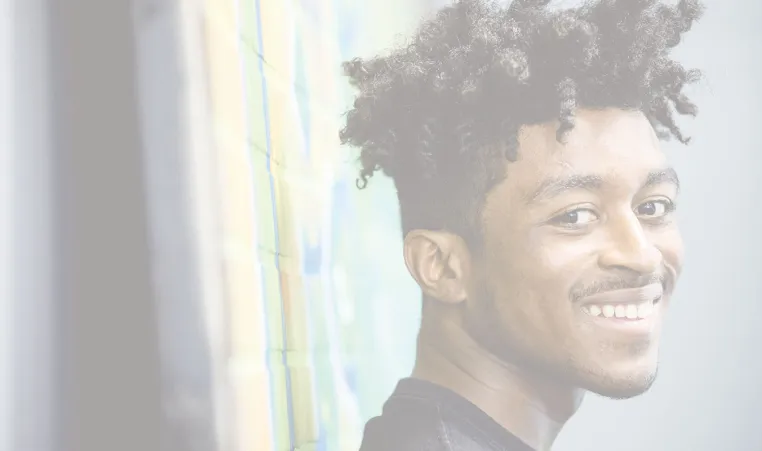
2021 | Written by Faith Schantz, Report Editor
James Brown Director of Creative Youth Development, The Lighthouse Project
The Lighthouse Project beams out of the Homewood-Brushton YMCA, an anchor institution in a community with one of the richest cultural heritages in the city. In a typical year, about 200 students participate in free, year-round music, media, and visual arts programming open to “any teens who can get to the Y,” says Director of Creative Youth Development James Brown, who runs the Lighthouse Teen Center. They can learn to use Photoshop, develop the technical and journalistic skills of podcasting, and serve as apprentices in a professional recording studio, among other skills. The arts are the reason to be there. “But so much of what we do is beyond or outside of the scope of the arts,” Brown says. The Lighthouse offers a safe space for teens to hang out, enjoy a meal, and get their homework done, in an environment that promotes honesty, camaraderie, and respect. When someone has a rough day or “things are complicated out in the world,” he says, “this is the place they come where they feel a sense of being picked back up.”
When Covid-19 closed down the Y, Brown felt they’d lost a key ingredient in their special sauce. “So much of our work here is about physically being together, which of course is exactly what the pandemic prevented us from doing.” They started to develop virtual programs, and loaned devices to students. The Lighthouse joined the Pittsburgh Learning Collaborative, a coalition of more than 80 organizations and individuals brought together by A+ Schools in response to the closing of schools. Brown and his team set up weekly check-ins for their students, telling them they could talk about whatever they wanted. And they set up check-ins among the staff to support one another’s mental health.
During lockdown, Brown and his colleagues found themselves thinking more about the synergy between the arts and emotional healing. “We were already a team that cared about people’s well-being,” he says. Watching “what young people were going through, staring at screens all day, feeling disconnected from family and peers, all the things that we all went through, we saw the potential for the arts to reconnect people and get through the tough times.” To better link the experience of making art with healing, they made some changes to their curriculum. And they added a teaching artist with a background in music therapy to the team.
Even before the pandemic, his team had a broad view of students’ needs. Some students attend the program full time, which amounts to close to 20 hours a week. Though Brown says, “We don’t pretend to know everything,” they do gain a wealth of information that in some cases could be productively shared with a student’s school. For example, staff might suspect that a student has an undiagnosed learning disability, but there’s no established channel for that kind of information to flow through. Operating in the space that has come to be known as “out-of-school time” (OST), he says, “Sometimes it’s a challenge to figure out where we plug in to be part of the ecosystem” that educates and supports the city’s youth.
For an OST provider to have a positive relationship with a school, schools first must value OST programs, Brown says. “That’s not to say that they don’t, but that value has to show up in ways that we can see,” such as the investment of time. Passing out a flyer about the program doesn’t cut it. In his view, young people don’t join programs “unless they either see the space, which means seeing their peers in action, or if they meet a mentor that they feel like they identify with, who has a skill set that’s relevant to what they’re interested in.” Ideally, his team would be invited into schools “to advance the learning within the school day,” working with classroom teachers to create relevant, collaborative, hands-on experiences. For example, it’s hard to teach the Civil Rights movement without its music, says Brown, who is a musician. “And we can bring technology and resources that the school may not have.”
This year, he thinks the arts should show up in any and all of the conversations happening across institutions, with more than lip service. “There’s always a champion for the arts in every conversation and everyone nods. But I think there’s still lingering skepticism about [the role] the arts play in tangible outcomes.” The pandemic revealed an array of student needs. He hopes people will also see the potential of the arts both to give students tools to share their creativity and to teach them about the world.
As summer ended, he was hoping schools, OST providers, corporate partners, and the wider community wouldn’t miss this moment of opportunity. “We’ve seen organizations, schools, people step up in amazing ways to support young people,” he says. “People pivoted to respond to the moment. I’m keeping my eyes peeled and trying to play my part in trying to turn that into lasting change.” He points out that all groups, including the business sector, came out of their silos to ensure students across the city had devices for online learning. The same groups could be engaged in thinking through how to support the entire youth experience, in collaboration with schools.
“I hope we don’t go back into those silos,” he says.
To learn more about the Lighthouse Project visit pittsburghymca.org/lighthouse.
https://www.ourschoolspittsburgh.org/stories-from-the-pandemic-lighthouse-project